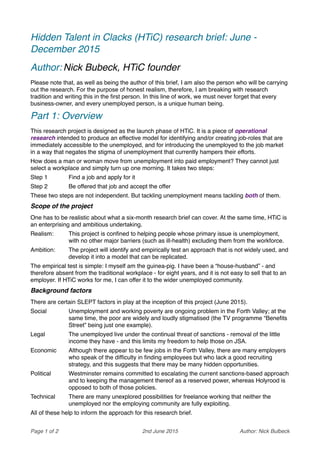
HTiC Research Brief
- 1. Hidden Talent in Clacks (HTiC) research brief: June - December 2015 Author: Nick Bubeck, HTiC founder Please note that, as well as being the author of this brief, I am also the person who will be carrying out the research. For the purpose of honest realism, therefore, I am breaking with research tradition and writing this in the first person. In this line of work, we must never forget that every business-owner, and every unemployed person, is a unique human being. Part 1: Overview This research project is designed as the launch phase of HTiC. It is a piece of operational research intended to produce an effective model for identifying and/or creating job-roles that are immediately accessible to the unemployed, and for introducing the unemployed to the job market in a way that negates the stigma of unemployment that currently hampers their efforts. How does a man or woman move from unemployment into paid employment? They cannot just select a workplace and simply turn up one morning. It takes two steps: Step 1! Find a job and apply for it Step 2! Be offered that job and accept the offer These two steps are not independent. But tackling unemployment means tackling both of them. Scope of the project One has to be realistic about what a six-month research brief can cover. At the same time, HTiC is an enterprising and ambitious undertaking. Realism:! This project is confined to helping people whose primary issue is unemployment, with no other major barriers (such as ill-health) excluding them from the workforce. Ambition:! The project will identify and empirically test an approach that is not widely used, and develop it into a model that can be replicated. The empirical test is simple: I myself am the guinea-pig. I have been a “house-husband” - and therefore absent from the traditional workplace - for eight years, and it is not easy to sell that to an employer. If HTiC works for me, I can offer it to the wider unemployed community. Background factors There are certain SLEPT factors in play at the inception of this project (June 2015). Social! Unemployment and working poverty are ongoing problem in the Forth Valley; at the same time, the poor are widely and loudly stigmatised (the TV programme “Benefits Street” being just one example). Legal! The unemployed live under the continual threat of sanctions - removal of the little income they have - and this limits my freedom to help those on JSA. Economic! Although there appear to be few jobs in the Forth Valley, there are many employers who speak of the difficulty in finding employees but who lack a good recruiting strategy, and this suggests that there may be many hidden opportunities. Political! Westminster remains committed to escalating the current sanctions-based approach and to keeping the management thereof as a reserved power, whereas Holyrood is opposed to both of those policies. Technical! There are many unexplored possibilities for freelance working that neither the unemployed nor the employing community are fully exploiting. All of these help to inform the approach for this research brief. Page 1 of 2! 2nd June 2015! Author: Nick Bulbeck
- 2. Part 2: the project This is a concise description of the project - a detailed explanation of day-to-day operations is not the concern of a research brief. Budget and resources It is vital to note that the typical unemployed person has little or no budget and is not paid to seek work. Likewise, this project begins with no specific financial input. I have two main resources. Myself! I have extensive experience of (and aptitude for) business networking, process and systems analysis, research per se, and starting an organisation from scratch. Generic resources! I have telephone and internet access, a great deal of information is publicly available, and more will become available to me as I establish and expand my functioning local network. If these resources seem unrealistic for the task, compare it with job-hunting while on benefits. All being well, I will additionally need to fit HTiC around whatever employment I am able to secure. Solving the problem of how to bring in other people to work on the HTiC model is part and parcel of the challenge of making the HTiC model replicable and sustainable. Research objectives This an operational research project, geared towards perfecting an as-yet-unused approach to solving the problem faced by an unemployed person: how do I get established in decent, long- term employment? Research approach An organisation is only as good as its people, and for HTiC in 2015, that means me. The approach is based, therefore, around as much face-to-face contact as possible with the target communities. The other important descriptor of the approach is that it will be an iterative development methodology, of the kind developed in the fields of software and mechanical engineering. That is: 1. Build a prototype using the available resources and information 2. Test the prototype in as realistic a setting as possible 3. Refine the prototype using the test results 4. Repeat Deliverables The fundamental deliverable is HTiC itself, as a charitable organisation with a recognisable product and methodology, and its own place: • In the local economy • In the research and development (or “think tank”) community This also defines the target audience: • Businesses and business groups in the Forth Valley • Other social entrepreneurs and research groups around the UK Timeline HTiC must “hit the ground running” in January 2016. June! Initial approaches to target audience: SWOT analysis July/August! Develop and present concrete proposals to target audience Sept - Nov! Build, use and refine recognisable HTiC products and services Dec! “Report”: published articles in media outlets recognised by the target audience Page 2 of 2! 2nd June 2015! Author: Nick Bulbeck